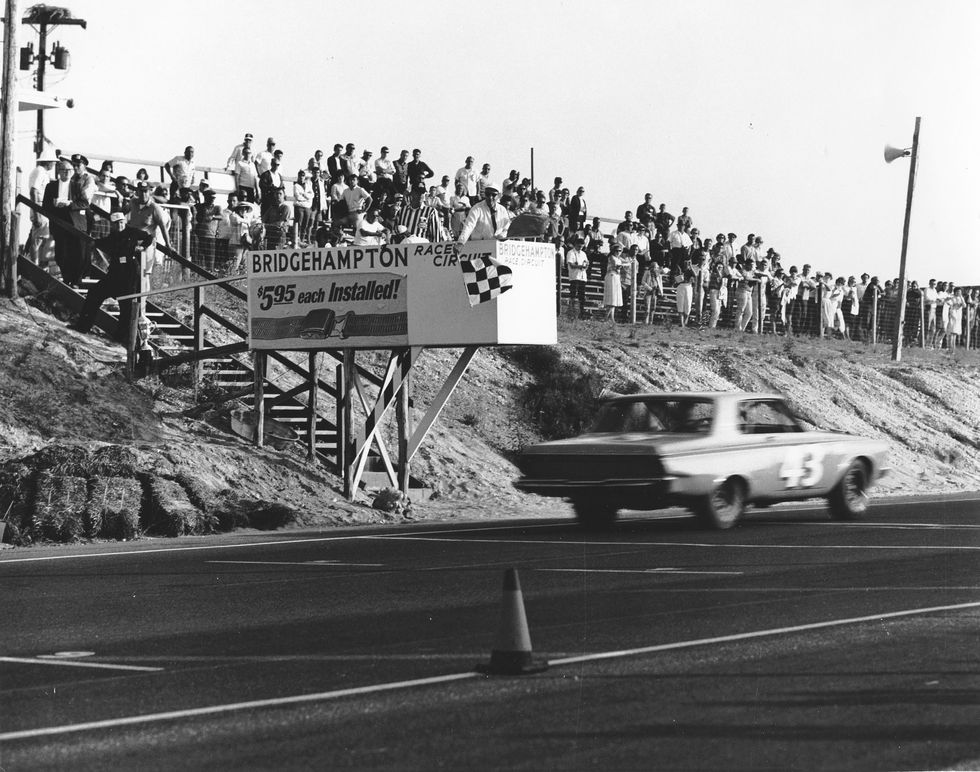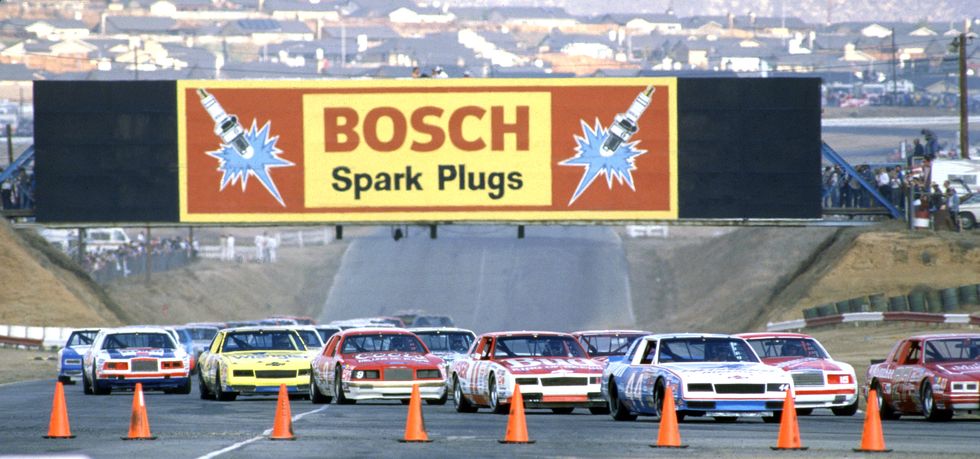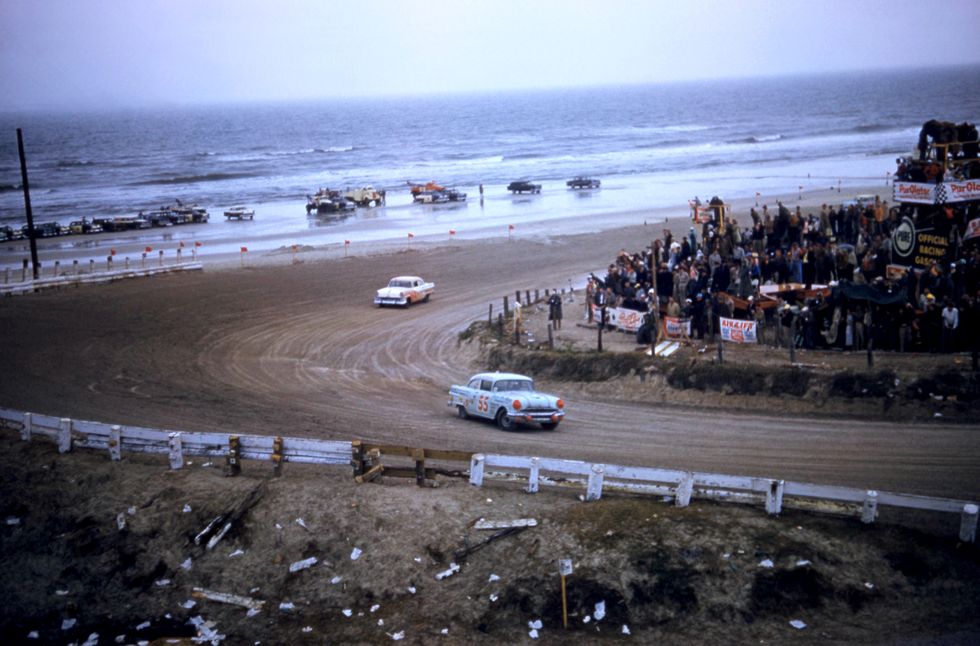- Known since its inception as primarily an oval-track discipline, NASCAR has long had a presence at left-hand, right-hand venues.
- All told, its top series has raced at least once at 16 of them, including three temporary circuits designed around airports.
- In fact, the first of its 155 road races (among 2,729 total events through last weekend) was at the Linden (N.J.) Airport in June of 1954.
While much of its upper-level corporate attention is focused on a single car in this weekend’s 24 Hours of Le Mans, the rest of NASCAR’s 30-some Cup Series teams are at another road race, this one at Sonoma Raceway in northern California.
In France, seven-time Cup Series champion Jimmie Johnson, past F1 champion Jenson Button, and Le Mans veteran Mike Rockenfeller will share a Hendrick Motorsports-prepared Chevrolet Camaro ZL1 in the Saturday-Sunday endurance race. It’s part of the Le Mans Garage 56 project, which is reserved for a car accepted for embracing what officials call “technology of tomorrow and beyond.”
The sanctioning body and corporate partners Goodyear, Chevrolet, and IMSA have invested countless millions in that one entry. Only 55 cars will start the twice-around-the-clock race, so by rule, the Garage 56 entry can’t win. The whole thing, for all intents and purposes, is a massive PR and media-driven campaign to draw attention to NASCAR and its sponsors. So far, it seems to be working.
Things will be quite different at Sonoma. There, 38 cars will run 110 laps around the 1.99-mile course (that’s 218 miles) in the year’s 16th points-paying race. It’s the second of this year’s six road races, after Circuit of the Americas in March. After Sonoma, the tour visits downtown Chicago in July, the Indy infield course and Watkins Glen in August, and the Roval at Charlotte in October. It’s been difficult to gauge fan interest, but some of the more discerning one seem more receptive to road racing today than in the recent past.
Known since its inception as primarily an oval-track discipline, NASCAR has long had a presence at left-hand, right-hand venues. All told, its top series has raced at least once at 16 of them, including three temporary circuits designed around airports. In fact, the first of its 155 road races (among 2,729 total events through last weekend) was at the Linden (N.J.) Airport in June of 1954. There, on a 2.00-mile course laid out among runways and taxiways, Al Keller won a 50-lap, 100-mile race in (gasp!) a Jaguar.
Other long-abandoned and mostly-forgotten venues hosted also road races during the early- to late-1950s. Among them were airport circuits in Montgomery, Ala. and Kitsap, Wa. The famous Bridgehampton Circuit on Long Island gave New Yorkers their first close-up look at NASCAR’s top series. Willow Springs (Ca.) Raceway, which hosted Cup races in 1956 and 1957, was a shooting location for the recent Ford v. Ferrari movie.
Finally, after years on less-than-ideal venues, NASCAR took its show to Riverside Raceway. The 2.63-mile track in the southern California desert hosted 48 races between 1958 and its closure in 1988. (FYI: In 1981 Riverside had races in January, June, and November; except for the 2020 COVID-impacted season, no other track has ever hosted three races in a season). Among the winners in its early days were “outsiders” Dan Gurney, Mark Donohue, A.J. Foyt, Ray Elder, and Parnelli Jones.
And, of course, plenty of NASCAR Hall of Fame drivers won there, too: Richard Petty, David Pearson, Cale Yarborough, Darrell Waltrip, Bobby Allison, Benny Parsons, Rusty Wallace, and Terry Labonte. Hall of Famer star Bill Elliott got his first career victory there, as did Ricky Rudd and Tim Richmond.
Watkins Glen International in upstate New York will host its 40th race in August, making it the senior citizen of NASCAR road courses. Stock cars first went there in 1957, but then not again until 1964 and 1965. They didn’t go back until 1986, but except for 2020 have raced there annually for the past 36 years.
In recent years NASCAR has added COTA and Road America to its schedule, plus the infield/speedway courses at Daytona Beach, Indianapolis, and Charlotte. Next month’s Big Deal in downtown Chicago (it replaces Road America on the schedule) will be NASCAR’s first street race but almost certainly not its last. It will be NASCAR’s most-hyped points race in years, maybe since the 1994 debut of the Brickyard 400.
The road course at Sears Point, Ca. came aboard in 1989, when Rudd dominated (61 of 74 laps) in beating Wallace, Elliott, Earnhardt, and Lake Speedway. Two years later, after last-lap contact with Davey Allison, officials withheld the checkered flag from Rudd and awarded the victory to apparent second-place finisher Allison. There was no fine, points deduction, or suspension for Rudd … just the victory he still understandably feels was taken from him.
What to Watch at Sonoma
This weekend’s Toyota Save Mart 350 will feature NASCAR’s most successful active road racers on the six current venues: former champions Chase Elliott has seven such victories and Martin Truex Jr., Kyle Larson, and Kyle Busch four each. Overall, Jeff Gordon (nine victories), Tony Stewart (eight), Rudd (six), and Wallace, Richmond, Bobby Allison, and Darrell Waltrip (all with five) lead the way. Despite all their successes, Johnson never won a road race and fellow seven-time champion Dale Earnhardt won only one.
Daniel Suarez, last year’s winner, is among five active drivers with Sonoma victories. Truex Jr. has three, Kyle Busch has two, and Suarez, Larson, and Kevin Harvick one each. Teams will practice and qualify late Saturday afternoon, then race at 3:30 (ET) on Sunday. With Noah Gragson sidelined with concussion-like symptoms, Legacy Motor Club has tabbed Grant Enfinger to drive the team’s No. 42 Chevrolet.
Elliott will return in the No. 9 Hendrick Chevrolet after missing last weekend’s St. Louis race. He was suspended a week for intentionally wrecking Denny Hamlin during the recent Coca-Cola 600 at Charlotte. He missed six early-season races due to a snowboarding accident and almost certainly must win to make the 16-driver Playoff field since making it on points seems unlikely.
First ‘Road’ Race Was on a Beach
Footnote: some will argue that NASCAR ran a road race in its very first season. Granted, a road was involved, but it’s a stretch to call the fabled 4.10-mile highway/beach course south of Daytona Beach a “road course.”
In July of 1949, after getting permission to close part of Route A1A (South Atlantic Avenue), NASCAR founder Bill France graded left-handed access turns so his new class of “Strictly Stock” racers could leave the pavement for the hard-packed sand beside the Atlantic Ocean. They’d run about two miles north to the other access turn, which led back to Route A1A and another two-mile run southward, toward Ponce Inlet.
France promoted 10 races (1949-1958) on the highway/beach course, shutting it down only after building the 2.5-mile Daytona International Speedway just west of his adopted hometown.
Once he ran the 1959 Daytona 500 on “the big track,” the highway/beach course became only a fond memory for long-time fans who occasionally still visit the site.
Contributing Editor
Unemployed after three years as an Army officer and Vietnam vet, Al Pearce shamelessly lied his way onto a small newspaper’s sports staff in Virginia in 1969. He inherited motorsports, a strange and unfamiliar beat which quickly became an obsession.
In 53 years – 48 ongoing with Autoweek – there have been thousands of NASCAR, NHRA, IMSA, and APBA assignments on weekend tracks and major venues like Daytona Beach, Indianapolis, LeMans, and Watkins Glen. The job – and accompanying benefits – has taken him to all 50 states and more than a dozen countries.
He’s been fortunate enough to attract interest from several publishers, thus his 13 motorsports-related books. He can change a tire on his Hyundai, but that’s about it.
Read the full article here






